Chicken drinking nipples are a fairly recent innovation in the backyard poultry world although the commercial industry has been using them for several years.
In fact, regular drinkers have not been used in the commercial poultry field for years.
One of the biggest benefits of drinking nipples is the fact that it keeps the water fresh and clean.
In this article we will explain how to set them up, how to train your chickens to use them, common problems with them and much more…
What Are Chicken Water Nipples?
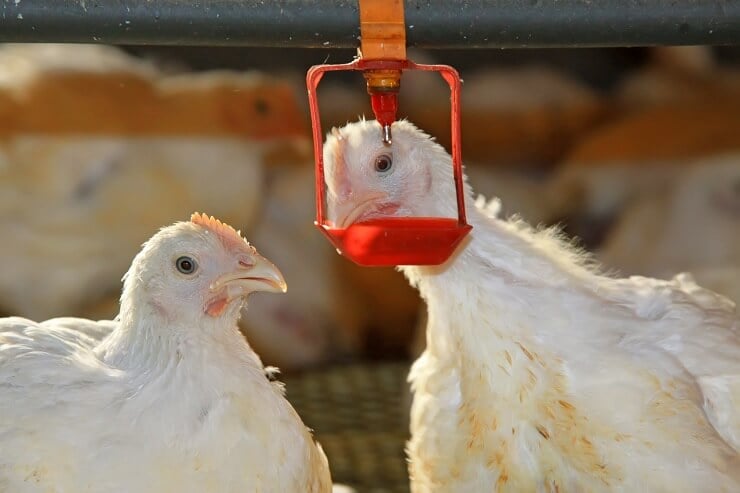 Chicken nipples are a handy little device designed to give water to chickens with minimal mess.
Chicken nipples are a handy little device designed to give water to chickens with minimal mess.
They are small devices that look a bit like a spark plug. They screw into a bucket or similar water holder. When pecked at, the device releases a few drops of water to the chicken.
There are two styles available; side mount and under mount (more on this later).
It is designed to cut down on wasted water that usually dampens bedding or makes puddles on the floor. This is a great improvement over regular drinkers which slop water all over the place when bumped or jostled by the birds.
Damp bedding as you know, is a lovely environment for bacteria to grow in, so anything that cuts down the potential for bacterial growth is an improvement.
Types of Nipple
THE BEST CHICKEN WATERER NIPPLE
Chicken Nipples (10 Pack)
- Keep your chickens water supply clean and fresh
- Takes less than 5 minutes to install
- 10 pack is suitable for up to 40 chickens
When it comes to chicken nipples you have a few different types to choose from. Here’s a brief rundown on the two types most commonly used:
- Horizontal: These fix into the side of the bucket/dispenser you have chosen. Once you have drilled the hole you simply push it in to the hole. These are spring loaded so the bird has to peck at it to release the water. These seem to be the most efficient.
- Vertical: Designed to fit under a container. These items work on the gravity principle, when the chicken moves the lever, water comes out.
These types come as ‘push in’ or ‘screw in’ fittings. The screw in types are further divided into those that are cleanable and those that aren’t.
Those that can be opened are simple in design and easy to clean – well worth the few extra pennies.
What Are The Benefits of Using Them?
There are several benefits to using nipples:
- Reduces waste: The nipple will dispense a small amount of water each time it is pecked. There should be no dripping from the valve and no leakage from your container.
- Keeps water clean: You can use a covered pail for a container so this will keep dust, dander and bedding out of the water. It also prevents the growth of mosquito larvae in the water.
- Reduces potential for bacterial growth: Bacteria love warm, damp environments to grow in. The nipple does not allow water to escape so damp bedding is eliminated.
- Easy to use: Once you have trained your chickens how to use it, it is very simple for them to use.
How to Set Them Up
THE BEST CHICKEN NIPPLE DRINKER
Horizontal Nipple Chicken Waterer
- The best style of drinker to keep your water clean
- This is the complete system, no assembly needed
- Built from 100% BPA free plastic
The tools and equipment you will need are:
- Marking Pen (to mark where the holes are going to be)
- Hand Drill and Drill Bit (to drill the hole)
- Silicone Caulk (used to seal the outside area, but not until you are sure of the device working)
- Pliers (to tighten up the nipples snugly to the bucket)
A nice little video that shows how to set-up side mount nipples can be found here.
It really is that straight forward. Standing the drinker on a platform for the birds to drink from is a great idea, especially since some of the bucket handles can be flimsy.
An under mount bucket has to be hung from something or rested on a suitably high platform.
Once you have got your drinker in place, you will need to troubleshoot any leaks you may have.
Generally this is a quick fix by tightening up the nipple to the container. If the water appears to leak from the lever this could be dirt in the tube – you will need to disassemble or keeping moving the lever to remove the dirt.
If it is leaking from around the unit where it screws into the bucket, you can try tightening the unit and if that doesn’t work, you will need to remove the nipple unit, dry thoroughly and place some Teflon tapes around the threads before screwing into the bucket.
If none of these suggestions work the unit may be defective so try another unit.
Training Chickens to Use a Water Nipple
This is probably the most difficult part! If you have young birds they are likely to take to the new system quickly, the older ladies will be slower to embrace changes.
If you can demonstrate to them how it works and perhaps have some of your more amenable girls try it with your help you are off to a good start.
It should not take too long before your girls are inquisitive enough to peck at the nipples, especially if you have removed all other drinkers from the area. The best time of year to try this is in the cooler weather – you don’t want them all gasping for water while they get the hang of using the new system.
It’s always a good idea to watch them for a while and make sure they are getting accustomed to the new style.
Hens that are partially sighted or blind may have some difficulty changing over to this type of system. The nipple requires some precision placement of the beak to be able to access the water.
I would recommend not changing over to a new system for those impaired hens unless you are willing to spend a lot of time training them.
Common Problems
Most of the problems that occur have to do with leakage. It is very important to follow the installation instruction carefully. Make sure the hole you drill is the right size.
When handling and placing the nipple be careful not to damage the piece while inserting it.
They come with a silicone washer on the screw-in side to ensure a tight compression fit. If your hole is too big, it won’t function well at all. Also ensure the unit sits up straight in the hole.
If the unit is leaking around the nipple itself, try taking it apart and cleaning it out. The outlet is tiny so a very small piece of dirt can cause a blockage to the ball.
You can buy chicken nipples almost anywhere but please be cautious about buying cheap, ‘knock offs’ – you get what you pay for.
Alternatives to Chicken Water Nipples
Apart from the old fashioned drinker that is in common use, there are a few different types of drinkers out there.
Best Standard Waterer for Hens
Galvanized Double Wall Founts
- Made from galvanized steel making it very durable and rust proof
- Heavy Duty making it much harder to flip over
- Steel construction making it compatible with heater bases
An alternative to the poultry nipple: The Poultry Cup
Automatic Chicken Drinker Cups
- Its design means it seldom needs cleaning and keeps the water clean for long periods of time
- Can be fitted both on the side and at the bottom of a drinker
- Very simply DIY installation
Alternative and Miscellaneous Waterers (Top Fill Waterers)
Large Top Fill Waterer
- Its top fill design and float makes it very easy to keep clean
- Can be used both indoor and outdoor
- Made from 100% BPA free plastic
Frequently Asked Questions
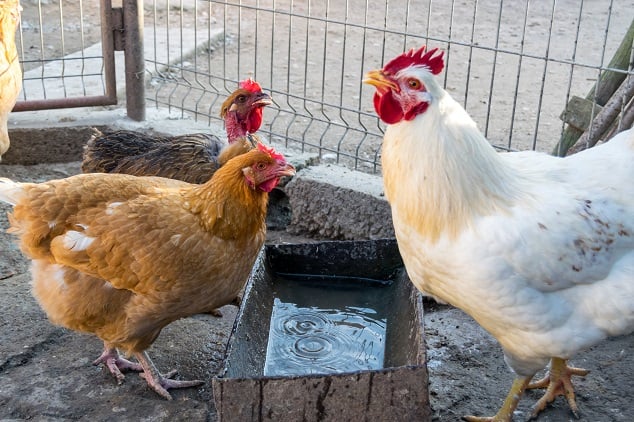
Can I use apple cider vinegar in the water?
No, the nipples have metal parts and the ACV will corrode them.
How long can the water stand in the drinker?
The water should be changed at least every 3-4 days.
Can I use them in winter?
That will depend on your setup. If the water or the nipples become cold enough, they will freeze up. If you are able to keep the entire system above 32-34F, they should be ok.
I like to put garlic in the water, can I do that?
No, there should be no additives to the water unless totally soluble. The debris from the garlic may block the nipple.
Is it suitable for baby chicks?
Yes. The only nipples not suitable for chicks are the side-mount horizontal ones. They are spring activated so a chick would not be strong enough to operate it.
Summary
THE BEST SMALL CHICKEN NIPPLE DRINKER
2 Gallon Chicken Waterer with Horizontal Side Mount Poultry Nipples
- This chicken waterer comes already set up with the nipples installed
- 2 gallon capacity suitable for up to 8 hens
- Made from BPA free plastic making it safe for your hens
Chicken nipple waterers can be a great labor saving device for you and a source of clean fresh water for your birds.
Remember though, its labor saving, not a ticket to bad practice!
The point being, you still need to keep the water fresh by replacing it at least every other day.
If they work as well as folks say they do, the savings on bedding alone would be significant and very welcome in a brooder with messy chicks.
The only real drawback is the inability to use garlic and apple cider vinegar with them.
Do you have chicken nipples in your coop? Let us know your experience with them in the comments section below…
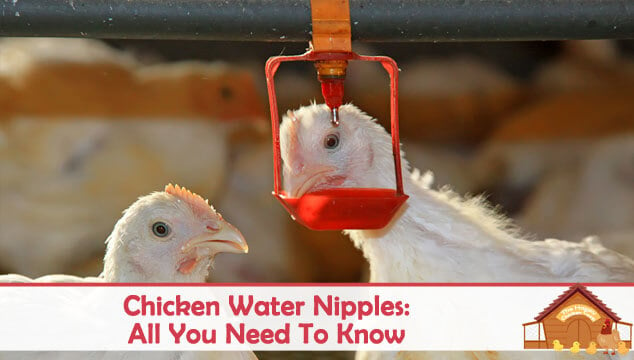


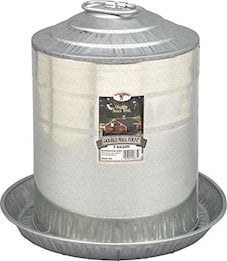

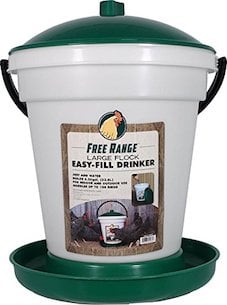



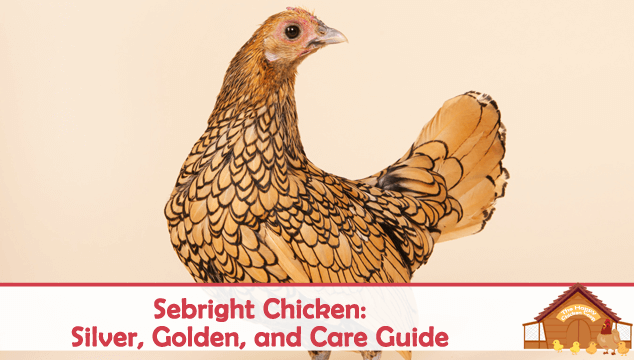
I have been using side mounted nipples since our chicks were about two months old. The metal piece that they have to peck is shiny and they took right to them. Don’t remember for sure but I think they are stainless steel. Never thought about them corroding so have been giving them ACV most of the time. Still no corrosion. I brush the nipples with a toothbrush when I clean the Waterer. Got these on Amazon if you want to look for the possibility of stainless steel. We love them! And love your blog; give you most of the credit for our happy, healthy, spoiled girls!
Any suggestions about how to keep the nipples from freezing in the winter? I’ve been having to switch to a different watering system in the winter (heated dog bowl), but it always gets so dirty so quickly.
Hi Michelle,
Unfortunately I haven’t found freeze-proof ones yet. When the temperature drops you would need to switch to a different watering system.
Claire
Hey All,
Actually these don’t freeze in the winter if you use the Farm Innovators 150 Watt Heater (It looks like a metal donut with a black cord coming out of one side 🙂
They work down to 0 degrees with this system. Our best tips are to keep them out of the wind and don’t use them with a bucket larger than 5 gallons if you’re using the suggested heater.
Hope that was helpful!
I use poultry cups on a 5 gallon bucket with a small stock tank heater inside. I think it would work just as well with nipples. I live in central Illinois and even the polar vortex did not freeze my chickens’ water with this setup.
We have been using the water-nipples with our ladies since they were young and we are very happy with the results. we were able to purchased the container with lid and nipples for very good price.
Get a heated poultry waterer! It’s the best thing for winter! You can find one at your local farm store/hardware store.
Mine has horizontal nipples and we just had -20 last night and water still isn’t frozen. Just plug in and go!
They work great once chickens get used to them ! Best advice i can give is use a drill bit 1 size smaller than what directions say. Nice tight fit. No silicone required!
what is the little red tray under the nipple in the top picture (with the 2 white chicks)?? its like a little drip tray? i cant seem to find that online..maybe be cause i dont know what its called?? never seen it before but i think it would help a lot for chickens who like to let drops fall while they are drinking..kind of a game to some of them it seems!!
It is a catch tray, so the nipple will release water and the red portion catches the drips, so it can act as a little sippy cup 🙂
Claire
Right..where can i buy them? any idea?
These have proven to work best for me : https://amzn.to/2J0yvVg
Claire
My Pet Chicken has them for a great price!
As a test I am using an upside down, plastic 1/2 gallon milk container with the vertical style of chicken nipple. The thickness of the lid proved to handle the nipple without leaking, whereas the underside of the container was too thin. (I do not have room for a bucket in the brooder.)
My issue is that the nipple does not allow in air as the chickens drink, so even though there is plenty of water in the container – about halfway, the nipple will not drip anymore until I release the pressure. I hope I explained that clearly.
Does a sealed bucket have this same issue? Anyone else using vertical nipples?
As an addendum I understand a small hole at the top will allow air in and let the nipple function correctly, but I have not read anywhere that was necessary. One of the touted advantages is that the lid keeps the water clean, but no mention of needing a hole for air. I just wanted to make sure I wasn’t missing “something”.
A typical lid isn’t airtight so some air is allowed in unless it is totally sealed
Drill a small hole in the lid. This will let air in
I need nipple
My nipples are clogged..they are releasing very little or no water..what methods should I do to clean them.
High pressure flushing, clogging on the tiny nipples happens often if your tank is full of very small debris
I just placed one of your nipple waterers into my little brooder for my 4 day old chicks. For the past 24 hours, they have been gathered around the nipple, attacking it obsessively. They are drinking some of the water (too much? can they drink too much?) but it’s drenching their bedding as well. They’re not so much drinking it as obsessing over it. Has anyone had this experience? Will they eventually stop obsessing over it? They literally stand in a circle around it and peck it, nonstop. Maybe a brief lull every 5 minutes, but as soon as 1 pecks the nipple, they all gather around to peck it. I’m tempted to put the old fashioned waterer back in there…believe it or not, it was less messy.
Maybe they need other toys to play with.
How old to chicks need to be before teaching them the horizontal/side mount nipples?
We were given 4 grown hens and all but one drink from the nipple. She pecks at the bucket and we cant seem to direct her to the nipple. I wonder if your suggestion about poor eye sight may be the problem.